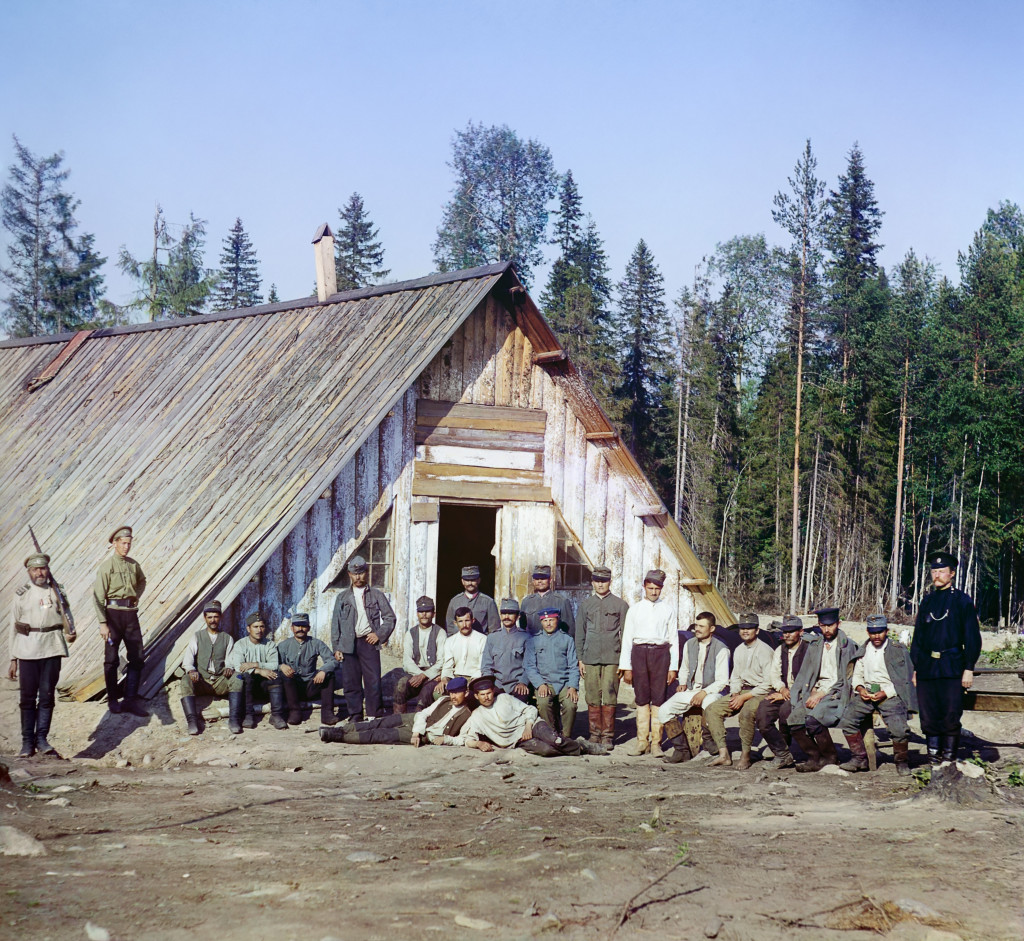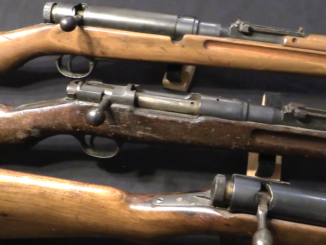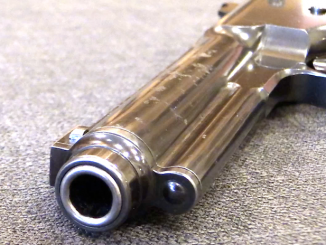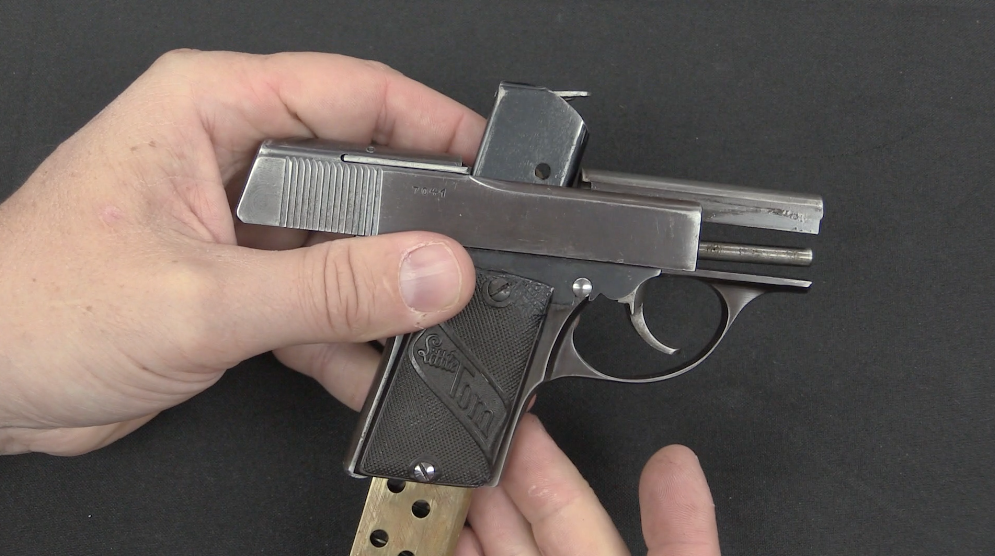
This photo is an original color picture, not a modern colorization – taken by Sergei Mikhailovich Prokudin-Gorsky, a pioneer of color photography. Also of interest, note that the Russian guard on the far left is armed with a Berdan II rifle (enlarge the photo for better detail).




“guard on the far left”
I am not expert in area of uniform/badges but notice that he also has 3 badges (can anybody identify?), has white гимнастёрка, epaulets are clearly visible – if I am not mistaken he is either ефрейтор or фельдфебель.
For Imperial Russian epaulets see table here:
https://ru.wikipedia.org/wiki/Русская_императорская_армия#.D0.A7.D0.B8.D0.BD.D1.8B.2C_.D0.B7.D0.B2.D0.B0.D0.BD.D0.B8.D1.8F_.D0.B8_.D0.B7.D0.BD.D0.B0.D0.BA.D0.B8_.D1.80.D0.B0.D0.B7.D0.BB.D0.B8.D1.87.D0.B8.D1.8F
(notice that background may vary between different units)
Does anybody recognize uniform of man standing most far right (dark blue)?
What is that “golubchik”, second from left doing there? He looks much younger, does not even wear customary beard.
Daweo, those aren’t badges they’re medals, but I can’t tell the colors of the ribbon, the far-right medal has the white-yellow-black imperial coloring.
As for the epaulets, he’s a efreitor. White coloring means he belongs to a transport battalion/company. I can’t read the writing but it could be some form of insignia.
Medal 1: Medal for Zeal (Good Conduct)
Medal 2: Coronation of Nicholas II medal
Medal 3: Commemorative Medal for the Tercentenary of the Romanov Dynasty
https://www.loc.gov/exhibits/empire/
You gotta feel sorry for the barefoot Austrian. Murmansk!
So far to my knowledge prisoners had two choices in Russia and later the Soviet Union: do exactly as you were told and work as a slave or be chopped to pieces or shot into hamburger in front of everyone else. Did I mess up?
“Did I mess up?”
Nope, you quoted all of the common stereotypes.
Yes you messed up. Again. That’s 3 choices.
Imperial Russia treated it’s POWs on a part with the rest of Europe. I recall Hans von Luck in WW2 speaking of efforts to recruit Germans as skilled labor. Russia is not your enemy now. Globalist is. WTFU
Judging from the way all ( POW’s and guards ) are dressed, the photograph appears to have been taken during a warmer part of the year. The barefoot prisoner may have simply taken off his boots for whatever reason.
An A-frame chalet in a wooded setting-better than a muddy trench.
Very good suggestion for Ian Maybe some day you could fo a story on my girl friends grandad or great grandad. Antoine Gazda the oerlikon story I have all the history for you Gazda engineering works rhode island
What I find interesting is the different shades/colors of the Russian uniforms, especially the gymnastyeorki(sp?).
The tsarist army was in logistical collapse almost from the start (as was the Red Army in 1941).
When Czech and Hungarian prisoners were in close proximity, there was always the chance for “lively discussions”, one of which led to the “Czech Legion” commandeering large sections of the Russian railway system.
“different shades/colors of the Russian uniforms”
Green color was introduced in 1907 for general usage.
Гимнастёрка was firstly white, because it was developed for usage of Turkestan Military District.
I just love the word “gymnastyorka”. It conjures all kind of meanings 🙂
“Tunic” might be right translation. But as I understand it also replaces shirt.
As I recall, the white version was shown being worn by the Russian contingent of the force that relieved the legations in Peking in the movie “55 Days at Peking”. Can’t say how accurate that was.
how in the sam hill did austrian prisoners get to murmansk? this is sorta curious? and, not very many of them, it would appear.
Most of the POWs captured by the Russians in the war were from the Austrio-Hungarian Empire – more than 2 million of them. As a result, they would have been kept in POW camps all over the Russian Empire.
Various minority groups amongst the POWs were encouraged to defect to the Russian side, and a number of them did, most famously the Czech Legion.
Good call! Now that you mention it, a lot of the fellows in the photograph appear to belong to minority ethnic groups of one sort or the other.
Same way soldiers go anywhere. Marching and trains. Duh
Good picture: here is the play of colours on AH uniforms we observed couple weeks back. Some are light blue, some dark grey.
Good picture indeed. Considering it’s over a hundred years old, and first generation color film, the color and clarity is amazing.
One thing is missing from the picture, a fence. Being where it was maybe a fence was not needed? Escape, to where?
Not Murmansk! Kivach, which is closer to Petrozavodsk.
It doesn’t even look like far north
It was just placed on the way of murmansk railroad
And Kivach is also near Kondapoga
And it is also near Kondapoga
I have been following your comments as to actual geographic location, and they make a great deal of sense — thanks very much for sharing your knowledge and viewpoint on this subject, and for clarifying the situation.
I mean – on prokudin-gorsky.ru (russian site) it’s said that this photo was taken near Kivach (which is waterfall), on prokudin-gorsky.org (international) it’s said about Kondopoga, which is about 31 miles from Kivach, but this is the closest town there.
Check out the boards used for the roof – those must be over 6 meters (~20) long – not a lot of those at the local lumber yards these days.
Was this photo an Autochrome or did he use another color process? Since photography is one of my other hobbies I’m always interested in the techniques.
Regarding variable uniform colors, remember that different suppliers, different dye lots and composition, and a combination of UV exposure and washing can turn supposedly uniform clothing into several different shades. Personally I have seen a lot of lightfastness issues with blue dyes so the A-H uniform color variation is more likely wear rather than inconsistent color as issued.
“A-H uniform”
Notice that Austria-Hungary in early 20th century were able to design up-to-date weapons system, but industry lacked power to produce it sufficient numbers.
As you might know default rifle was Mannlicher 1895, but older Mannlicher design were also used (part was rechambered from old 11mm cartridge to new 8mm) – these were not very worse that 1895 as they were also magazine-feed straight-pull repeater, but even obsolete Werndl rifles were used.
Other example is 30,5-cm-Belagerungsmörser, modern siege howitzer and obsolete M.80 (standing for 1880 year) series of artillery weapons (12-cm Kanone, 15 cm Mörser, 15 cm Kanone, 18 cm kurze Kanone. Other example of still used obsolete artillery system was 7cm Gebirgskanone M.75 (standing for 1875 year)
http://www.passioncompassion1418.com/Canons/Eng_AfficheCanonGET.php?IdCanonAffiche=1087
Other examples are dreadnoughts build before WW1: SMS Tegetthoff (not to be confused with ironclad of same name), SMS Viribus Unitis, SMS Prinz Eugen (not to be confused with ironclad of same name), SMS Szent István, aswell improved dreadnought (known as Ersatz-Monarch class) which finally were never finished. But still used obsolete ship, like SMS Kronprinz Erzherzog Rudolf ironclad.
He used something like we know as techicolor: he took one picture for 1 color channel (CMY colors in this case) – one for yellow, one for blue, and one for magenta (here you can see those layers http://memory.loc.gov/service/pnp/prokc/20200/20279v.jpg). He used a special camesa for this. He could only print his photos using chromolithography (http://prokudin-gorskiy.ru/library/pg/card/75b.jpg – postcard with his colour photo). Another way to show those pictures was to form color image on a screen using three projectors for each colour.
What I find interesting is that the POW’s appear to be in a similar physical condition to their captors, i.e., in pretty good shape, and they seem quite relaxed ( check out the subtleties such as the body language and facial expressions ). Model prisoners, perhaps, photographed for propaganda purposes — or is it possible that the horror stories of POW mistreatment in this theater of war are not all quite true, and yet another long-held, commonly-accepted myth is about to be debunked? Perhaps the treatment varied from camp to camp, depending on the local regional commander and camp commandant.
Either way, we in the West and the so-called “Free World” have long been given the impression that “the other side” is always somehow more brutal and uncaring in its dealings with captured enemy soldiers. While a lot of it is actually true ( witness the Bataan Death March, the Siamese Railway construction, etc. ), I suspect that, equally so, a good deal of it has been exaggerated for obvious political and military purposes. The so-called “good guys” have, in recent years, been gradually revealed to be no better, or worse, in a lot of situations than their erstwhile counterparts.
I think it’s pretty well accepted that things were a bit more genteel in WWI than later in the century, at least away from the actual knife-edge of the fighting.
Quite so.
Treatment of POWs is most likely to vary by distance from the front and logistics. If adequate food is not available, then the priority will likely go to your own before prisoners. And the AH had a lot of problems supplying quality boots. Could be that guy’s fell apart on him! These POWs appear to be decently fed, clothed and housed considering th state of Russian logistics.
Prisoners are sent to wherever their combination of labor service and supply needs are most useful. Timber, mining, farm work and stevedoring usually.
That’s why Axis prisoners in 1940-45 were shipped to Canada and the U. S. It was more efficient to send them west in otherwise empty ships and let them replace the absent men on the farms than to send east their food and soldiers to guard them.
I suspect there’s a timber operation for these men to go to- they are too clean for mining. And that more of these men went home unhurt than a similar group of active soldiers from 1916.
As long as they went home generally safe and sound, that is one small but significant aspect of humanity in that otherwise terrible conflict to be thankful for, regardless of nationality, creed, political affiliation, ethnicity, etc.
There is an excellent article about this early form of color photography (and a very “darn interesting” website in general where it is found) at the following link:
https://www.damninteresting.com/color-photos-from-the-world-war-i-era/
CG